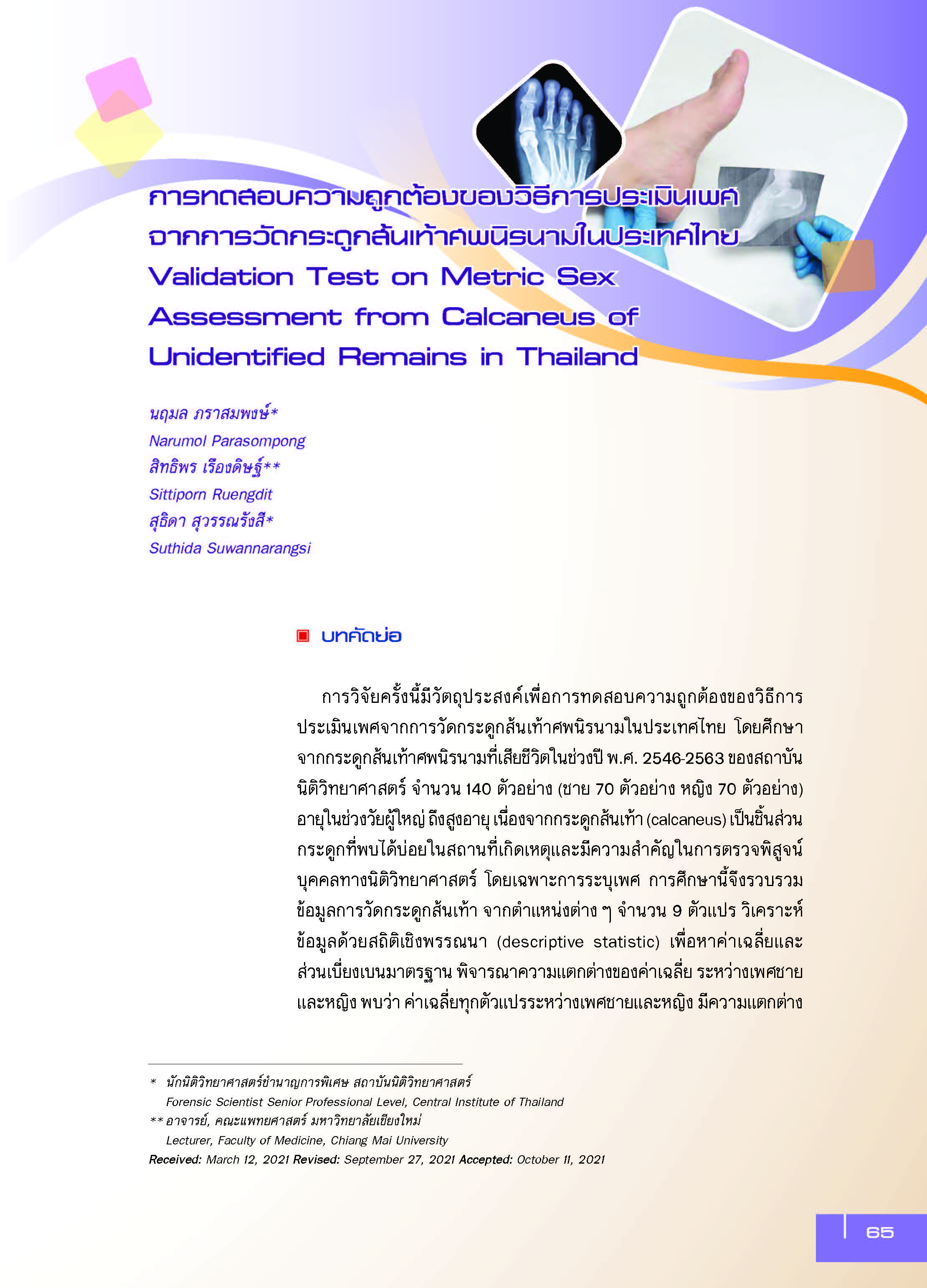Validation Test on Metric Sex Assessment from Calcaneus of Unidentified Remains in Thailand
Main Article Content
Abstract
The objective of this study is to validate the metric sex assessment by calcaneus measurement of unidentified remains in Thailand. A total number of 140 calcaneus samples (70 males, 70 females) of the Central Institute of Forensic Science were selectively collected from the unidentified bodies found dead during 2003-2020 and with adult to elderly age range. The calcaneus is a common bone fragment usually found at crime scenes and plays an important role for individual profile in forensic investigation, especially the sex identification. In this study, the skeletal measurement of calcaneal samples collected from different positions under nine variables was examined. Data were analyzed using descriptive statistics with mean and standard deviation. Consider the means between males and females, all nine variables were found to be significantly different. For the study of gender classification, the accuracy of model equations for sex estimation was between 72.9 to 80.0% in males and 75.7 to 82.9 in females, according to the discriminant analysis based on the stepwise method. In comparison between other population groups and Thai populations in other regions, it was found that the equations were specific to each population as well as Thai population in other regions. Hence, this study can be utilized for sex estimation from unidentified remains in Thailand.
Article Details

This work is licensed under a Creative Commons Attribution-NonCommercial-NoDerivatives 4.0 International License.
Published Manuscripts are the copyright of the Journal of the Justice System. However; the opinions that appeared in the content are the sole responsibility of the author.
References
ณัฐธิดา ศรีนาค. (2563). การศึกษาวิธีการจัดการศพไร้ญาติและศพนิรนามของประเทศไทยและต่างประเทศ. วารสารกระบวนการยุติธรรม, 13(2), 139-152.
Bidmos, M. (2006). Metrical and non-metrical assessment of population affinity from the calcaneus. Forensic Science International, 159(1), 6-13.
Bidmos, M. A., & Asala, S.A. (2003). Discriminant function sexing of the calcaneus of the South African Whites. J. Forensic Sci, 48(6), 1213-1218.
Bidmos, M. A., & Asala, S. A. (2004). Sexual dimorphism of the calcaneus of South African blacks.J Forensic Sci, 49(3), 446-450.
Bidmos, M. A., & Asala, S .A. (2005). Calcaneal measurement in estimation of stature of South African blacks, 126(3), 335-342.
Bidmos, M. A., & Dayal, M. R. (2003). Sex determination from the talus of South African whites by discriminant function analysis. Am J Forensic Med Pathol, 24(4), 322-328.
Buccino, E., Ubelaker, D., Hayek, L., & Zerilli, A. (1999). Evaluation of seven methods of estimating age at death from mature human skeletal remains. J forensic Sci, 44(5), 931-936.
Buikstra, J. E., & Ubelaker, D. H. (1994). Standards for data collection from human Skeletal Remains: Proceedings of a seminar at the Field Museum of Natural History. Fayetteville: Arkansas Archeological Report Research Series.
Bunning, P. S. C., & Barnett, C. H. (1965). A comparison of adult and foetal talocalcaneal articulations. J Anat, 99(1), 71-76.
Byrnes, J. F., Kenyhercz, M. W., & Berg, G. E. (2016). Examining interobserver reliability of metric and morphoscopic characteristics of the Mandible. Journal of Forensic Sciences, 62(4), 1-5.
Holland, T. (1995). Estimation of adult stature from the calcaneus and talus. Am. J. Phys. Anthropology, 96(3), 315-320.
Introna, F., Vella, G. Di., Campobasso, C.P., & Dragone, M. (1997). Sex determination by discriminant analysis of calcaneus measurements. J. Forensic Sci. 24(2), 725-728.
Peckmann, T. R., Orr, K., Meek, S., & Manolis, K. (2015). Sex determination from the calcaneus in 20th century Greek population using discriminant function analysis. Sci. Justice, 55(6), 377-382.
Perini, T. A., Oliveira, G. L., Ornellas, J. S, & Oliveira F. P. (2005). Technical error of measurement in anthropometry. Rev Bras Med Esporte, 86-90.
Russo, E. G. (2007). Sex determination from the talus and calcaneus measurements. Forensic Sci Int, 171(2-3), 151-156.
Scott, S., Ruengdit, S., Peckmann, T. R., & Mahakkanukrauh, P. (2017). Sex estimation from measurements of the calcaneus: Applications for personal identification in Thailand. Forensic Science International, 278, 405.e1-405.e8.
Steele, D. G. (1976). The estimation of sex on the basis of the talus and calcaneus. Am J. Phys. Anthropology, 45(3), 581-588.
Ulijaszek, S. J., & Kerr, D. A. (1999). Anthropometric measurement error and the assessment of nutritional status. British Journal of Nutrition, 82(3), 165-177.
Wanpradab, S., Prasitwatthanasaree, S., & Mahakkanukrauh, P. (2011). Sex determination from calcaneus in Thais. Journal of Associated Medical Sciences, 44(1), 53.
Ward, R., & Jamison, P. (1991). Measurement precision and reliability in craniofacial anthropometry: Implications and suggestions for clinical applications. Journal of Craniofacial Genetics and Developmental Biology, 11(3), 156-164.
Weinberg, S. M., Scott, N. M., & Neiswanger K. (2005). Intra observer error associated with measurements of the hand. American Journal of Human Biology, 17(3), 368-371.


